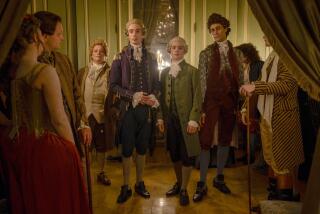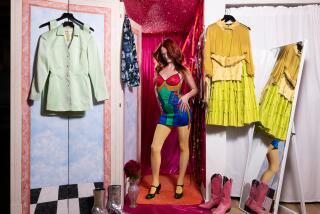MAGIC
- Share via
In William Kennedy’s new novel, “Quinn’s Book,” a 17th-Century industrialist bemoans the appearance of English soldiers “in tatters so advanced that ladies were advised to avert their eyes when passing.”
A similar eye for propriety was evident at the MAGIC (Men’s Apparel Guild in California) trade show at the Convention Center this week. The conservative merchandise and muted displays of more than 3,000 exhibitors convincingly demonstrated that, GQ notwithstanding, most men care less about what is in, than about simply covering their bodies.
Even Vision Street Wear’s skateboard-oriented clothing line, one of the few to make an identifiable visual statement, courts a customer that may not be interested in fashion.
“Some (of our clients) care, some don’t,” said Brad Dorfman, president of the 12-year-old skateboard firm that has made sportswear for two years.
“Those who do care want a street look, as opposed to a surf look,” he said. “They mainly want black, which is simple, fashionable and easy to wear.”
Dark colors predominate here, punctuated by tie-dye and bold street graphics, as well as by a fit that accommodates the skateboard life style.
The pants have peg legs, and, to facilitate movement, loose hips and thighs. Heavyweight jeans feature double-reinforced knees that can withstand falls or abuse.
Ca Va, an award-winning Seattle-based company, is working the opposite end of the spectrum. Their clothes blend the frequently antithetical qualities of “sophistication and fun,” and are aimed at fashion-conscious men from 20 to 50.
“These consumers probably bought the Britannia label back when it was the only game in town, and a pink shirt was as wild as men’s clothes got,” said Tom Hermann, president of the 2-year-old firm.
“They are older now, but still don’t like oxford- cloth shirts and khaki pants. Because they don’t have the money for Armani or Hugo Boss, they look for affordable, wearable, quality fashion.”
Ca Va’s clothes are meant to impress without being gaudy. One sport jacket, for instance, is cut quite short “to give it a better look when men put their hands in their pants pockets.”
An Inverness cloak updates the Sherlock Holmes look with details, such as a scarf loop, that are not generally found in $200 overcoats. A cotton duster is oversize and water-repellent.
By nature, Hermann explains, this market is resistant to change. For starters, “men are far more loyal to a label than women are. Once they find a company they like, they will seek it out and stick with it.”
Most of these companies and their customers are more than happy to let someone else try the unusual new looks on for size. “It takes at least 18 months for an idea to filter down to a mass level,” Hermann says.
“We always knew, for example that the baggy thigh, narrow-leg pant was more comfortable. But it took years for men to wear that silhouette. Now that it’s established, tighter pants feel strange.”
As if to prove his point, there, right in the middle of the Levi Strauss fashion show, was a pair of baggy-thigh, narrow-leg jeans. That wasn’t all. There were also pleated jeans, stonewashed jeans and jeans with Girbaud-inspired labels at mid-fly.
More to Read
Sign up for our Book Club newsletter
Get the latest news, events and more from the Los Angeles Times Book Club, and help us get L.A. reading and talking.
You may occasionally receive promotional content from the Los Angeles Times.










